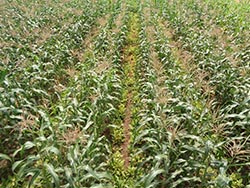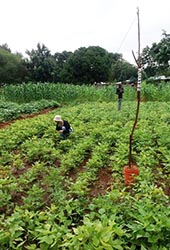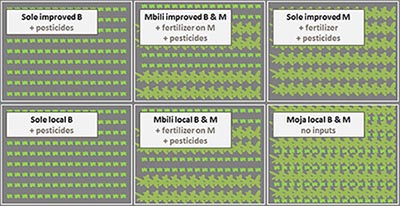Beans and maize are important food and cash crops for farmers in the Northern highlands of Tanzania. They are often intercropped to achieve efficient land use, to avoid risk and to improve soil fertility. Farmers commonly alternate the rows of maize and beans one-by-one – or moja-moja in Swahili. The practice of planting maize and beans in a two-by-two (mbili-mbili in Swahili) alternating rows design has been introduced relatively recently (Figure 1). These cropping designs are referred to as moja and mbili cropping designs (Figure 2). The mbili design had been introduced from Kenya and was proposed as a method to improve light availability for beans.
 |
Left Figure 1. Mibili-mbili maize and beans Right: Figure 2. Intercropped maize and bean at a demonstration trial |
 |
The aim of my MSc thesis study was to further explore these two intercropping designs in Tanzania, in terms of resource capture. There was a special interest in light availability for beans (Figure 3), the proportions of nitrogen fixed by beans in the different cropping designs, and the differences between local and improved varieties of beans and maize.
 |
Left: Figure 3. Light interception measurements above and below the canopy Right: Figure 4. Maize bean intercropping M is maize, B is bean |
 |
During the second rainy season of 2016, the moja and mbili intercropping designs with maize and beans were included for the first time on six N2Africa demonstration trials in the Kilimanjaro Region. Each of those trials consisted of six plots with various combinations of crop varieties, cropping design and input use. The available treatments are depicted in Figure 4. The setup of the demonstration trials was not ideal for comparing sole and intercropped designs, because there were no plots available with sole-cropped local maize or with a moja-intercropped improved varieties. The moja design that was available (with local maize and bean varieties), represented the common intercropping practice in the region: no application of fertilizers and insecticides. Those inputs were used on all other plots, however. The moja design was almost an additive design compared to sole-cropped maize, but the spacing between maize rows was slightly wider in the moja-intercrop.
Relative yields of local maize were reduced by moja intercropping, compared to sole cropping. The increased total plant density sometimes compensated for the relatively poor performance. For the mbili intercrops, relative yields of the local and the improved bean and maize varieties were as expected based on the differences in plant densities of the intercrops and sole crops. Land equivalent ratios of the mbili designs were around 1 or slightly larger for most of the trials.
A larger fraction of photosynthetically active radiation (PAR) was available for beans (transmitted by the maize canopy) in the mbili intercrops than in the other designs.
Estimates of the proportion of N fixed ranged a lot. Estimates were largest for moja-intercropped local beans compared to the other designs, but too few data were available for statistical testing. On all plots except one, more nitrogen was fixed than was removed through harvesting of bean seed.
Grain and stover yields of the improved maize variety dropped faster with an increasing disease severity than for local maize. However, for similar diseases scores, yields of the improved variety were still often similar or larger compared to local maize.
It is expected that alterations in the row spacing in the mbili design may improve its land equivalent ratio. A next step will be to monitor the development of the component crops throughout the whole cropping season.
My thesis report can be found on www.N2Africa.org.
Eva Thuijsman, Wageningen University & Research
